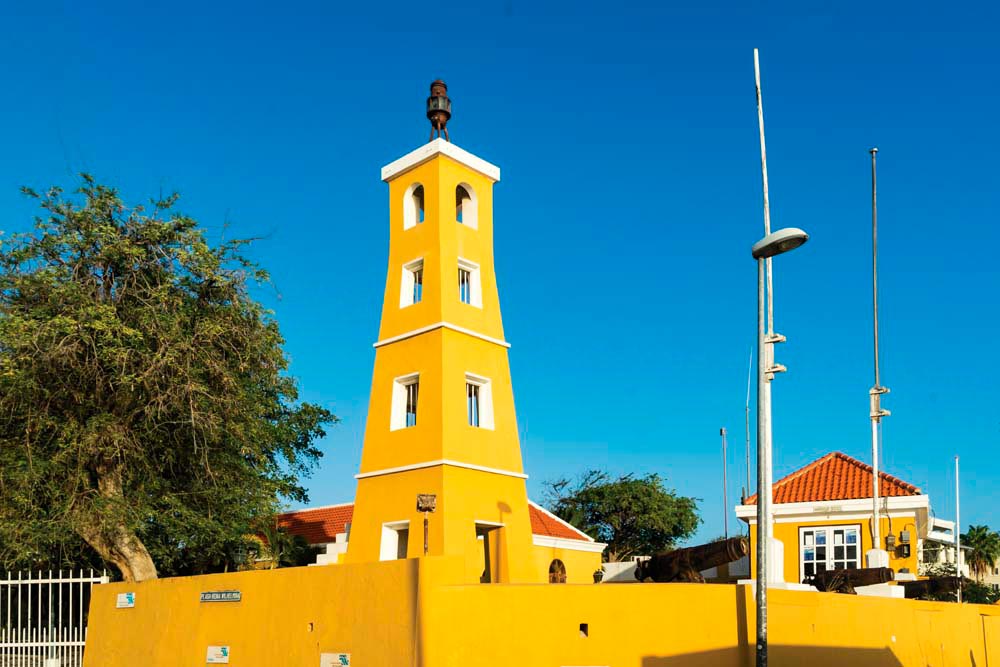Streetscape
With a population of just over three thousand and few buildings over two storeys tall, Kralendijk has an atmosphere some call sleepy, others call laid-back. The downtown area — “Playa,” to most locals — is a short stretch of often brightly painted buildings with shops and offices. On the seafront, Wilheminaplein — Wilhemina Square, named for the former Dutch queen — looks over the turquoise waters of the harbour, and is also the location of a small vegetable market with austere columns and arches. The town lighthouse and the Catholic church, St Bernard’s, are painted the same eye-catching orange. Just beside the church, the Terramar Museum gives a concise overview of Bonaire’s history, including archaeological artefacts.
Saturday excursion
Saturday is market day in many parts of the Caribbean, and for Bonaireans that means heading to the small inland town of Rincon, about seven miles north of Kralendijk (above left). The weekly market is a cornucopia of fruits and vegetables, local delicacies and crafts, flowers and garden plants, and much more. When you’re done shopping, explore the town, Bonaire’s oldest surviving settlement (founded in the sixteenth century).
Take the plunge
The pristine waters surrounding the island — sometimes described as gin-clear — and its coral reefs teeming with marine species, heavily protected since the early 1970s, make Bonaire one of the world’s top dive sites, on every scuba enthusiast’s bucket list. Numerous dive shops in Kralendijk offer equipment, lessons, and tours — and, of course, snorkelling is a good option for those who prefer to stick to the surface. There are amazing dive experiences to be had even within sight of the Kralendijk waterfront. And if you’re a sociable diver, there’s no better time to get wet than during the annual Bonaire Dive Week, running from 26 May to 2 June this year, with a non-stop programme of activities in and out of the water.
Look up
An absence of smoke-spewing heavy industry and relatively little light pollution mean Bonaire has unusually clear night skies — so much so that locals talk about their “Sky Park,” the nightly overhead display of heavenly bodies. The undeveloped eastern side of the island is the best place for stargazing, and Bonaire’s location near the equator means that, depending on the time of year, you can see both Northern and Southern Hemisphere stars in a single night. So walk with your star chart — or the digital equivalent on your smartphone.
A pinch of salt
The perfect Bonaire souvenir? Locally produced sea salt, from the salt pans on the coast south of Kralendijk (above). You can buy it coarse or finely ground, in jars, pouches or boxes — and if you’re too useless in the kitchen even to boil water, you can also find sea salt–infused bath and body products, too. Long after your visit, you can fill your tub at home and pretend you’re soaking in Bonaire’s crystal waters.
History
Inhabited since about 1,000 CE by the indigenous Caiquetios — whose intriguing petroglyphs and rock paintings are still to be found in caves around the island — Bonaire was first visited by the Spanish in 1499. Seizing the island in 1636, Dutch settlers built Fort Oranje to protect their new colony, and the town of Kralendijk — “coral dyke” — grew up around it. For generations, the harvesting of sea salt was the leading industry, with backbreaking labour provided by enslaved Africans, under grim conditions, until Emancipation in 1862.
During the Second Word War, Bonaire was the location of a US air base and internment camp for Germans, and many locals worked as sailors on board oil tankers. A war memorial in Kralendijk honours those who lost their lives in U-boat attacks. After the war, like many other Caribbean islands, Bonaire turned towards tourism, with a special focus on diving.
Co-ordinates
12.1º N 68.25º W
Sea level
Caribbean Airlines operates daily flights to and from its headquarters at Piarco International Airport in Trinidad, with connections on other airlines to Flamingo International Airport in Bonaire
























